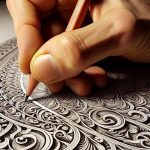Have you ever wondered about the fascinating origins of fabric weaves?
In this article, we’ll take you on a journey through time, tracing back the historical roots of these intricate techniques.
From ancient civilizations to the modern innovations of today, we’ll explore how fabric weaving has evolved over the centuries.
Join us as we uncover the secrets behind these timeless creations and discover the rich history that lies within each thread.
Table of Contents
Ancient Fabric Weaving Techniques
To understand ancient fabric weaving techniques, you need to explore the intricate methods employed by our ancestors. Ancient weaving techniques hold a significant place in the history of human civilization. They not only represent the mastery of craftsmanship but also carry immense cultural significance.
In the ancient world, fabric weaving was a highly regarded skill passed down through generations. Different civilizations developed their unique weaving techniques, resulting in a wide variety of patterns, styles, and designs. The intricacy and precision of these techniques showcased the creativity and artistic abilities of our ancestors.
The cultural significance of ancient weaving techniques can’t be overstated. Fabrics woven using these techniques played a crucial role in the social, economic, and religious aspects of ancient societies. They were used for clothing, ceremonial attire, and even as a form of currency in some cultures. The patterns and symbols woven into the fabric often carried deep cultural meanings, representing the identity and beliefs of the community.
Studying ancient weaving techniques not only provides insights into the technical skills of our ancestors but also offers a glimpse into their values, traditions, and way of life. It allows us to appreciate the rich tapestry of human history and the cultural heritage that has been passed down to us. By understanding these ancient techniques, we can preserve and honor the legacy of our ancestors while also inspiring innovation in modern fabric weaving.
Evolution of Fabric Weaves in the Middle Ages
Continuing from the previous subtopic, let’s explore the evolution of fabric weaves in the Middle Ages. During this time, medieval weaving techniques saw significant advancements, leading to the emergence of new techniques and designs. One of the key factors that influenced the development of fabric weaves during this period was the impact of guilds.
Guilds played a crucial role in regulating and controlling the production of textiles. They established strict guidelines and standards for weaving, ensuring the quality and consistency of fabrics. Guilds also facilitated the exchange of knowledge among weavers, leading to the exploration of innovative techniques.
Below is a table showcasing some of the notable medieval weaving techniques and their characteristics:
| Weaving Technique | Characteristics |
|---|---|
| Tapestry Weave | Elaborate designs created by weaving weft threads in a discontinuous manner. Used for decorative wall hangings and upholstery. |
| Twill Weave | Diagonal lines formed by interlacing warp and weft threads. Provides durability and texture. Commonly used for heavy fabrics like denim and tweed. |
| Damask Weave | Intricate patterns created by using a combination of satin and twill weaves. Often used for luxurious fabrics such as silk and brocade. |
The guilds’ influence on fabric weaves during the Middle Ages cannot be overstated. By establishing standards and fostering knowledge exchange, they paved the way for the development of new techniques and designs, shaping the fabric industry for centuries to come.
Influence of Global Trade on Fabric Weaves
As you delve into the influence of global trade on fabric weaves, you’ll uncover how the exchange of goods and ideas across borders shaped the evolution of textile techniques and designs.
One of the most significant impacts of colonization on fabric weaves was the introduction of new materials and weaving techniques. European colonizers brought with them their own textile traditions, such as the use of mechanized looms and the production of fine fabrics like silk and lace. These new techniques and materials gradually infiltrated local textile industries, leading to the development of hybrid styles and designs.
Furthermore, the cultural significance of fabric weaves in different regions can’t be overlooked. Fabrics have long been used to convey cultural identity and transmit stories and traditions. Through global trade, fabrics and their weaves became a means of cultural exchange and communication. Textiles from different regions reflected the unique aesthetics and symbols of their respective cultures, allowing people to express their heritage and assert their identity. The trade of fabrics also facilitated cultural diffusion, as patterns and motifs from one region were adopted and incorporated into the textile traditions of another.
Industrial Revolution and the Mass Production of Fabrics
During the Industrial Revolution, you witnessed a significant shift in the production of fabrics with the introduction of mechanized processes and the mass production of textiles. This period marked a turning point in the history of fabric production, transforming it from a labor-intensive craft to a highly efficient and mechanized industry. The impact on labor was profound, as the new technological advancements drastically reduced the need for skilled artisans and increased the demand for unskilled workers.
The invention of the spinning jenny by James Hargreaves in 1764 revolutionized the textile industry. This machine allowed multiple spindles to spin yarn simultaneously, increasing production capacity and reducing the reliance on manual labor. Similarly, the power loom, developed by Edmund Cartwright in 1785, automated the weaving process, further accelerating the production of fabrics.
These technological advancements resulted in the mass production of textiles, enabling fabrics to be produced on a larger scale and at a lower cost. This led to the growth of textile factories and the concentration of workers in urban areas. While the Industrial Revolution brought economic prosperity and increased access to affordable fabrics, it also had its downsides. The working conditions in the factories were often harsh, with long hours and dangerous machinery, leading to protests and the eventual formation of labor unions.
Modern Innovations in Fabric Weaving Techniques
You can explore the advancements in fabric weaving techniques that have emerged in modern times. Technological advancements have revolutionized the way fabrics are woven, leading to increased efficiency and sustainability in the process.
One key innovation is the development of computerized looms, which have replaced traditional hand-operated looms. These computer-controlled machines allow for precise control over the weaving process, resulting in more consistent and intricate patterns. Additionally, computerized looms can work at a much faster pace, increasing production efficiency.
Another notable advancement is the use of sustainable materials in fabric weaving. With growing concern for the environment, manufacturers are now exploring alternative fibers such as bamboo, hemp, and recycled materials. These fibers are not only eco-friendly but also offer unique properties like breathability and durability.
To further illustrate the advancements in fabric weaving techniques, let’s take a look at the following table:
| Technique | Description | Benefits |
|---|---|---|
| Jacquard Weaving | Uses a series of punched cards to control patterns | Allows for intricate designs and complex patterns |
| Air Jet Weaving | Utilizes compressed air to propel the weft yarn | Faster production and reduced energy consumption |
| Water Jet Weaving | Uses high-pressure water to insert the weft yarn | Versatile and suitable for a wide range of fabrics |
| Rapier Weaving | Employs a rapier to carry the weft yarn | Can weave a variety of yarns, including delicate ones |
These advancements in fabric weaving techniques not only improve the quality and efficiency of production but also contribute to a more sustainable textile industry. As technology continues to advance, we can expect further innovations in fabric weaving that prioritize both performance and environmental responsibility.
Frequently Asked Questions
What Are the Different Types of Fabric Weaves Used in Ancient Times?
In ancient times, people used various fabric weaves for their traditional clothing. These ancient fabric weaving techniques included plain weave, twill weave, and satin weave, each with its unique characteristics and uses.
How Did Fabric Weaving Techniques Evolve During the Middle Ages?
During the Middle Ages, fabric weaving techniques evolved through a historical analysis. The development of these techniques contributed to the growth of the textile industry. Let’s explore how weaving techniques in the Middle Ages played a role in this.
Which Countries Played a Significant Role in Shaping Global Trade in Fabric Weaves?
Countries like China, India, and Egypt played a significant role in shaping global trade in fabric weaves. Their cultural influences and production techniques impacted the industry, making them key players in the development and spread of different weaving methods.
What Were the Major Advancements in Fabric Weaving During the Industrial Revolution?
During the Industrial Revolution, advancements in fabric weaving had a significant impact. Innovations like the power loom and spinning jenny revolutionized textile production, increasing efficiency and output.
What Are Some Recent Technological Innovations in Fabric Weaving Techniques?
Some recent technological innovations in fabric weaving techniques include the development of smart textiles, which incorporate electronic components, and 3D weaving, which creates three-dimensional structures for enhanced functionality and design possibilities.
- The Use of Nonwovens in Construction and Civil Engineering - July 11, 2025
- The Use of Nonwovens in Construction and Civil Engineering - July 11, 2025
- The Use of Nonwovens in Construction and Civil Engineering - July 11, 2025




